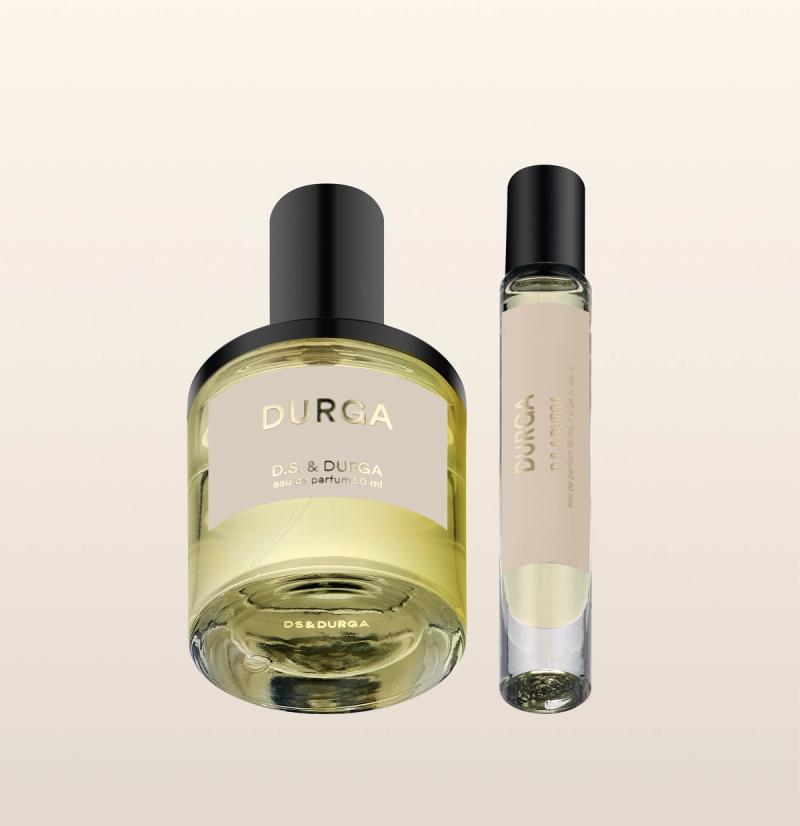Durga
Perfume
Afterpay Available
Palatial doses of the finest floral absolutes—tuberose, orris butter, orange blossom, sambac jasmine, chrysanthemum, and ylang. Unimaginably narcotic.
Our gold label line employs copious amounts of the rarest, finest perfume materials. It is limited to small, hand-made batches, driven by the scarcity of rare natural ingredients.
Top Notes
- green tuberose
- melon
- chrysanthemum
Heart Notes
- ylang ylang
- orris butter
- orange blossom
Base Notes
- tuberose absolute
- sambac jasmine
- fine musc
Afterpay available on U.S. orders $50+
Afterpay available on U.S. orders $50+


Kavi and I both love the flower tuberose. It was the scent of Kavi’s early visits to Delhi. Her uncle would place fresh tuberose flowers next to her bed every day.
The tuberose flower is creamy white, green, and narcotic. While most people would love the smell of the flower, many do not like tuberose perfumes. Often when it is recreated as a perfume, it comes out sugary, soapy, or cloying. Tuberose absolute is prohibitively expensive, thus many “tuberose” perfumes have little or none of the absolute in them.
In order to make most of the great flowers sing, the perfumer must employ the “off-notes” present in the real thing. Tuberose with out mushroom-earth will not smell real. Nature does a tremendous job of balancing the off notes with the good notes and that’s why we love flowers (and more importantly pollinating insects and animals do!).
For years, I tried to make a great tuberose scent. Some were ok, but they usually smelled like tuberose perfume, not the flower. I tried many things, until I broke down a sample I had over the course of a few days. I started to smell its melon, mushroom, rot, and the slickness of the petals’ grassy green freshness and its haunting tea note.
Durga uses the most amount of tuberose absolute I have ever seen used in a perfume. The supporting cast only adds to its richness. This scent is the pinnacle of what we do. It is a scent excited about the materials we as perfumers live and search for. I can see why Jean Patou named the fragrance Joy. Sometimes it is just that simple.
Durga puts together some of our favorite materials in the world: rich flower absolutes. Besides the tuberose, there is:
Orris butter with a high irone content. Along with Oud, Orris Butter (a concrete made from the root iris pallida flowers), is probably the most prized raw material in the world. It takes 3 years to extract from the root, and the yield is low. Its lasting powdery effect is halfway towards the dryness of the fabled ambergris. Like many great materials, it provides a natural contrast dry vs butter, woody vs floral.
Orange Flower Absolute. The richest expression of the bitter orange tree –which also gives us bitter orange (called bigrade) oil from the expressed fruit, neroli from the distillation of its flowers, and petitgrain from the leaves and twigs, among a few other specialties. Orange Flower Absolute is solvent extracted from the flowers. It is a thick brown floral-vegetal mass, muddy but also crisp. It ‘s on the way to jasmine absolute. Some grades go from smoke, leather, all the way towards an almost onion like pungent floral heart. In dilution it sings of hills around the cote d’azur, Morocco, etc.
Chrysanthemum concrete. This is a rarely used material. It is a strange scent. Slightly off-putting by itself. It is chalky, and has a thick dried apple note, with hints of sulphur. It adds a realness to the tuberose – giving a green fruit and chalky earth that helps extend the fullness of tuberose.
Jasmine Sambac. Too much could be said about this oil – one of the most important items in the perfumers palette. Along with rose otto and jasmine grandiflorum, jasmine sambac has the mystical ability to meld together disparate contrasts into a “perfume.” It is effusively narcotic, with a a honey sweet syrup of green fruit and indole (mothballs). It is a perfume in itself. The flower represents so many cultures – India, Bhutan, Indonesia, the Philippines. It goes by many fantastic names – Motia, mogra, Matsurika, etc. It is written about in songs and poetry. It rests in the abode of lovers laying in the moonlight, yadda yadda yadda.
Ylang Ylang. One of the greatest modifiers, ylang ylang is white, wet, and calming as opposed to the raw animal sex of jasmine. I like ylang ylang, which like lavender induces a state of calm— on my pillow before sleep. Ylang is a classical floral modifier especially with jasmine. It can quietly sit in the back and add touches of cooling wet spice to the heart of floral fragrances.-D.S.
Ingredients

Alcohol Denat., Fragrance (Parfum), Water (Aqua), Alpha-Isomethyl-ionone, Benzyl Alcohol, Benzyl Benzoate, Benzyl Salicylate, Farnesol, Hydroxycitronellal, Limonene, Linalool

